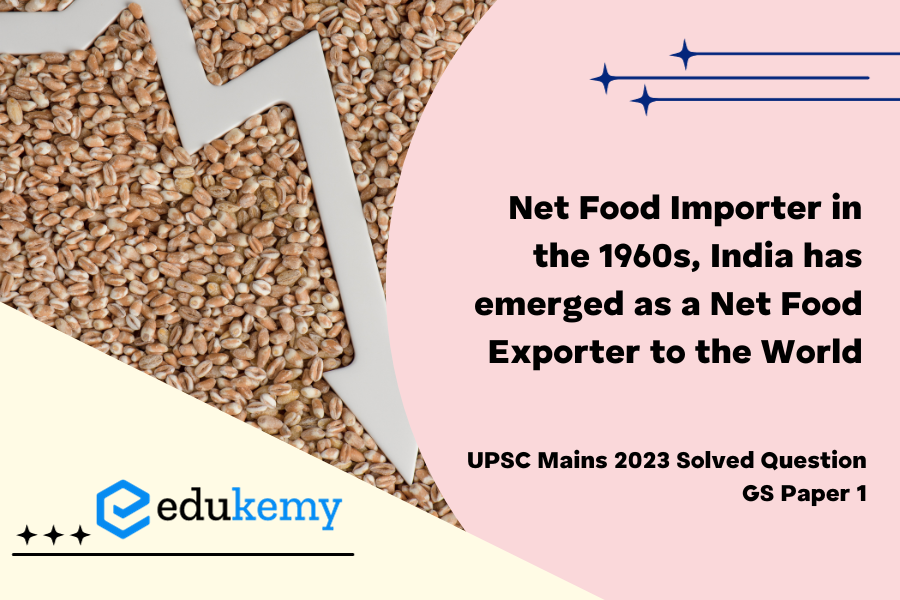UPSC Mains General Studies Paper – 1 Mains 2023
UPSC Mains Civil Services IAS Exam Question Paper – 2023
Contents
Introduction
India, previously reliant on food imports and aid, has undergone a remarkable shift, emerging as a significant agricultural exporter. This transformation has been achieved through continuous improvements in irrigation, infrastructure, diversification of crops, favorable policies, and proactive export promotion strategies over the years. As a result of these efforts, India has established itself as a prominent player in the global agricultural export market.
In the 1960s, around 75% of the Indian population was dependent on agriculture yielding meagre productivity. Wheat imports amounted to 10-11 million tons, including the import of PL-480 substandard wheat type from the USA in a ship to mouth situation. Presently, India is among the top ten exporters of agricultural products in the world with a total production increase from 51mT (1951-52) to 342 MT (2021-22).
Body
The reasons for this change of status from ‘net importer’ to ‘net exporter’ are multiple-
- Green Revolution: The Green Revolution, initiated in the 1960s, introduced high-yielding crop varieties (phase1- wheat, phase2- rice), modern farming techniques, and increased use of fertilizers and irrigation. This led to significant increases in agricultural productivity.
- Financial support: Government measures in providing low cost credit via NABARD and insurance and social security schemes through regional rural banks provided a safety net to relatively poor Indian farmers to invest in agriculture.
- Operation Flood: launched by NDDB in 1960, aimed at sustaining the dairy industry economically while providing employment to poor farmers. Increased milk production augmented rural Incomes and ushered in the era of milk cooperatives like- Amul, Saras, etc. Presently, India is the largest producer of milk, with nearly 24% of global milk production.
- Economic reforms and ease of doing business-1990s reforms opened up India’s economy. Steps like formation of APEDA allowed for greater private sector participation in agriculture and exports. The present initiatives through APEDA, B2B exhibitions have also facilitated in exploring potential export markets.
- Crop Diversification: In India, the Green Revolution led to diversification beyond traditional grains. For instance, Punjab, known for wheat and rice, diversified into cotton cultivation, contributing significantly to cotton production and exports.
- Government Support: The Indian government’s Minimum Support Price (MSP) program ensures a guaranteed price for crops like wheat and paddy, providing price stability and encouraging farmers to produce more. This support has increased food production and exports.
- Technological Progress: India’s adoption of genetically modified (GM) cotton varieties revolutionized the cotton sector. Bt cotton, engineered to resist pests, has made India one of the world’s largest cotton producers and exporters.
- Trade Liberalization: India’s participation in trade agreements like the South Asian Free Trade Area (SAFTA) and the World Trade Organization (WTO) has opened up markets for products such as basmati rice, spices, and seafood, resulting in increased exports of these commodities to various countries.
| Note Largest producer – milk, pulses and jute Second largest producer- sugarcane, groundnut, vegetables, fruit and cotton Leading producers – spices (turmeric in pharmaceuticals), fish, poultry, livestock and plantation crops. CASE STUDY India – the largest producer of millets (the recent push on millets in the international year of millets). Benefits – rich in dietary fiber’s, climate resilient crops, minimal water requirements. |
Challenges
- Sustainability: Intensive farming practices and the excessive use of chemicals raise concerns about soil health and environmental sustainability.
- Climate Change: Erratic weather patterns and the impact of climate change pose risks to crop production and food security.
- Smallholder Farmers: Many smallholder farmers still face challenges in accessing credit, technology, and markets, limiting their ability to participate in the export market.
- Infrastructure: Insufficient storage and transportation infrastructure can lead to post-harvest losses and affect the quality of exported goods.
Conclusion
Agriculture in India has achieved grain self-sufficiency but the production is resource intensive, cereal centric and regionally biased. The recent FAO report that about 74% of the Indian population are unable to afford a healthy diet. The data points to the dire need of a 2nd green revolution driven by an agenda of ensuring permanent access to healthy diet at affordable cost.
In case you still have your doubts, contact us on 8792740517.
For UPSC Prelims Resources, Click here
For Daily Updates and Study Material:
Join our Telegram Channel – Edukemy for IAS
- 1. Learn through Videos – here
- 2. Be Exam Ready by Practicing Daily MCQs – here
- 3. Daily Newsletter – Get all your Current Affairs Covered – here
- 4. Mains Answer Writing Practice – here
Visit our YouTube Channel – here


